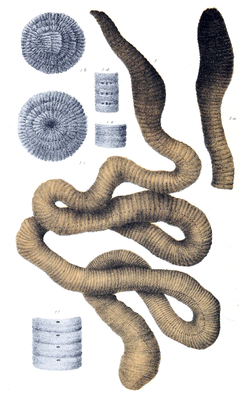Megascolides australis
| Megascolides australis | ||||||||||||
|---|---|---|---|---|---|---|---|---|---|---|---|---|

Megascolides australis |
||||||||||||
| Systematics | ||||||||||||
|
||||||||||||
| Scientific name | ||||||||||||
| Megascolides australis | ||||||||||||
| McCoy , 1878 |
Megascolides australis , English Giant Gippsland earthworm , is a species of the little bristle (Oligochaeta) from Australia , which belongs to the Megascolecidae family. It was discovered by Frederick McCoy in Gippsland , Victoria ,in 1878. The worm reaches a length of 80 cm to 3 m.
distribution
The species is endemic to the Bass River (Victoria) area in the south of Gippsland. The only 40,000 hectare distribution area forms a triangle between the villages of Loch , Korumburra and Warragul . The worms are rarely seen on the surface of the earth. They live in damp places within 40 m of the river banks, especially the smaller tributaries of the Bass River. In some places they occur quite frequently, up to ten individuals per cubic meter of earth have been observed.
Way of life
The worms feed on roots and plant debris in the soil. In case of danger, they retreat to their buildings, which extend 1 to 1.5 meters into the depth. Inhabited buildings are always kept damp. The presence of the worms can also be recognized by the gurgling sound they make when they retreat into their burrow. Scientists often knock on the ground with a spade and can thus determine whether noises indicate the presence of worms. Megascolides australis is a long-lived worm with relatively slow generation changes. Research to date suggests that it takes five years to reach sexual maturity. Adaptation to a change in environmental conditions can therefore not always take place quickly enough.
Reproduction
As a representative of the belt worms (clitellata), the species has a clitellum, a glandular epidermal formation that is important for reproduction. The genital organs are also located within the clitellum, which in Megascolides australis particularly swells between spring and summer. The worms are hermaphrodites, but need a partner to reproduce. The 5 to 9 cm large amber-colored egg cocoons are placed in side chambers, which branch off an average of 22 cm below the surface of the structures of the adult animals. Only one worm develops from each cocoon after about 12 months.
literature
- BJ Smith, JA Peterson: Studies of the Giant Gippsland Earthworm Megascolides australis McCoy 1878 . In: Victorian Naturalist . tape 99 , 1982, pp. 164-173 .
- Beverley D. van Praagh: The Ecology, Distribution and Conservation of the Giant Gippsland Earthworm Megascolides australis McCoy 1878 . In: Soil Biology and Biochemistry . tape 24 (12) , 1992, pp. 1363-1368 .
- Beverley D. van Praagh: Reproductive biology of Megascolidesb australis McCoy (Oligochaeta: Megascolecidae) . In: Australian Journal of Zoology . tape 43 , 1996, pp. 489-507 .
Individual evidence
- ↑ See illustration in: Museum Victoria Science Reports Nos 2-5 ( Memento from September 6, 2007 in the Internet Archive ) (PDF; 231 kB)
- ↑ A specimen of Megascolides australis reached an entry in the Guinness Book of Records with a length of 3 m (see: Recognizing Australian Earthworms)
- ^ Smith and Peterson 1982
- ↑ Van Praagh 1992
- ^ Van Praagh 1996
- ^ Van Praagh 1996
Web links
- Megascolides australis in the endangered Red List species the IUCN 2009. Posted by: World Conservation Monitoring Center, 1996. Retrieved on December 30 of 2009.